“When the first baby laughed for the first time, its laugh broke into a thousand pieces, and they all went skipping about, and that was the beginning of fairies.”
~ Sir J. M. Barrie, Scottish journalist, writer, and dramatist (1860-1937)
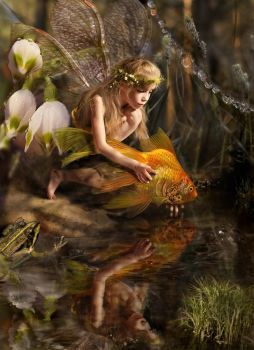
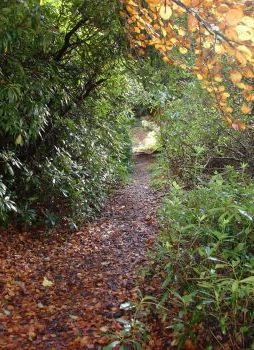
One autumn afternoon in Edinburgh, I tiptoed round a centuries-old close—a passageway or courtyard—trying not to infringe on anyone’s privacy as I snapped a few photos of ivy-covered walls.
A small woman of perhaps sixty was busily tending the potted plants outside her door. Her gray hair was caught in a clip on the crown of her head, and her blue eyes shone with an inquisitive gaze.
After we exchanged pleasantries, she wanted to know why I’d come to Scotland.
“Doing research for a novel,” I explained.
Minutes later I walked through the arched door of her two-story dwelling, stunned that a complete stranger would invite me into her home for a cup of tea.

As I took my seat, she gestured toward a circle of pink rose petals on the bare wooden floor. “Had I known you were coming,” she said, “I would have spelled out your name.”
“Ohh,” I sighed, imagining how she might have formed the letter L in her flowery script.
Her nimble hands ever busy, she showed me an intricately patterned sweater she was knitting for a friend, then described how she’d affixed pressed flowers to her mantelpiece using some mysterious process involving glue and a coating of polyurethane.
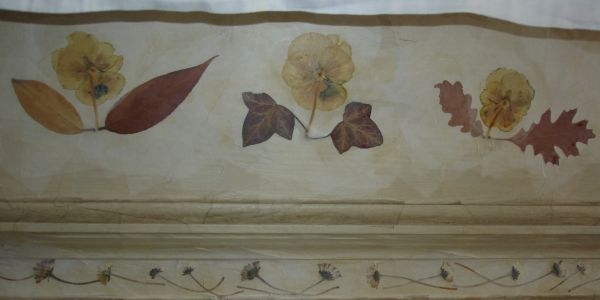
I confess I began to wonder if she had fairies living at the bottom of her garden. Not that I believe in the wee folk, mind you. But how else to explain this whimsical, charming woman existing in our modern world?
She was kindness itself, offering a plate of shortbread along with a lively show-and-tell of her many creations. We chatted about books and art, about gardens and food, about the Bible and the wisdom it contains.
When I stepped back outside, blinking in the sunlight, her house nearly disappeared behind the greenery. It didn’t look quite like this, but not far from it.
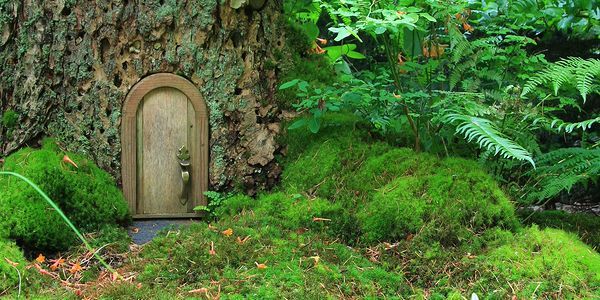
Had I sipped tea with a fairy? No. My new friend was delightfully eccentric, but very much of this realm. Still, I was in Scotland, a country brimming with fairy lore.
The farther north into the Highlands you venture, the more likely you are to hear about fairies. You’ll also stumble upon place names like Fairy Glen on the Isle of Skye. With its many small lochs and cone-shaped hillocks. the glen looks like an entire landscape done in miniature. Perfect for…aye.
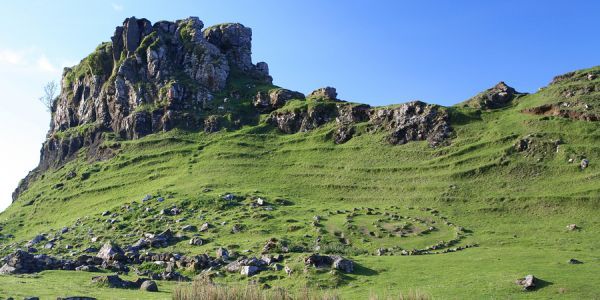
Eve Blantyre Simpson, in her book, Folk Lore in Lowland Scotland (1908), told of a learned gentleman who was asked if he believed in fairies. The Highlander replied as gravely as if his confession of faith had been challenged, “Of course I do.”
Even people with strong religious beliefs embraced the notion of fairies, kelpies, and brownies in centuries past. Scottish fairy lore is rich with descriptions of the creatures and their habits. Fairies, it seems, are mischievous and not to be trusted. Cross a fairy and you may find yourself elf-shot.
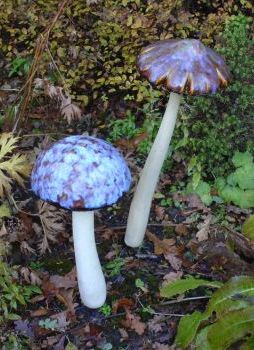
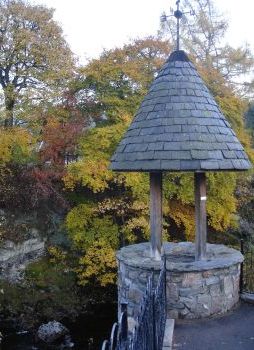
In my fourth Scottish historical novel, Grace in Thine Eyes, Davina McKie is a young woman of seventeen who has lost the ability to speak, yet finds myriad ways to communicate. Here’s a brief exchange from chapter twelve:
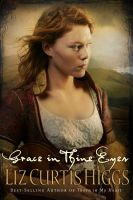 Davina held out the page with its single, bold question: Have you ever seen a fairy?
Davina held out the page with its single, bold question: Have you ever seen a fairy?
Her mother, Leana, considered Davina’s diminutive height, her fair complexion and luxuriant red hair, her gift for music, her playful nature, and her penchant for green dresses. Aye, and her utter silence. Fairy motion was said to be soundless.
“Have I ever seen a fairy?” Leana traced her daughter’s freckled cheek with maternal affection. “Only when I look at you.”
Whether covered in moss or Scottish bluebells, gardeners of old trod across small clearings with care, lest they disturb the fairies that gathered there to dance. I didn’t spy a single flutter of wings round this promising spot near Eilean Donan Castle in the Highlands.
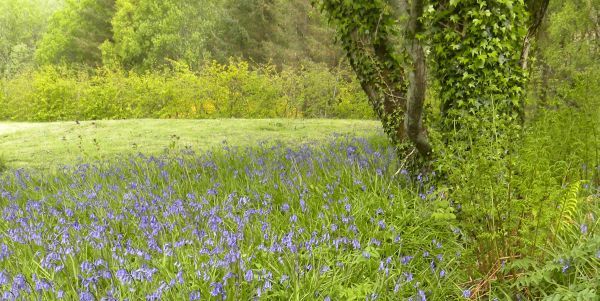
Does Scotland really have fairies? Davina didn’t think so. Her cousin asked her, “Wherever did you see the wee folk?” Davina winked and pointed to her head. Only in here, lass.
“Up the airy mountain,
Down the rushy glen,
We daren’t go a-hunting
For fear of little men.”
~William Allingham, Irish poet and editor (1824-1889)
I find the topic of fairies intriguing, if only because it shows us how people over the centuries have yearned for a world beyond the natural one. You can study the fairy lore of old in classic books like Scottish Fairy and Folk Tales by George Douglas, An Illustrated Treasury of Scottish Folk and Fairy Tales by Theresa Breslin, and The Fairy Faith in Celtic Countries by Walter Yeeling Evans-Wentz.
I’ll close with a sprinkling of fairy-themed poetry and an invitation to leave a comment regarding this question: From the Tooth Fairy to Tinkerbell, did you ever believe in fairies?
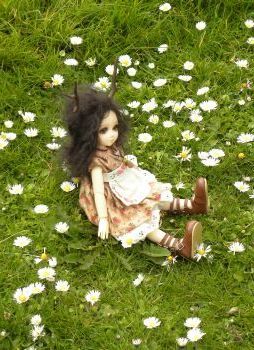 “Fairies use flowers for their charactery.”
“Fairies use flowers for their charactery.”
~ William Shakespeare, English dramatist and poet (1564-1616)
“Be secret and discreet; the fairy favors are lost when not concealed.”
~ John Dryden, English poet and dramatist (1631-1700)
“The dances ended, all the fairy train
For pinks and daisies search’d the flow’ry plain.”
~ Alexander Pope, English poet and critic (1688-1744)
“Did you ever hear
Of the frolic fairies dear?”
~ Frances Sargent Osgood, American poet (1811-1850)

 Subscribe to the blog via RSS
Subscribe to the blog via RSS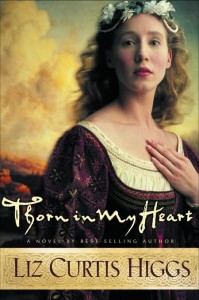
I heard the smallest of tinkling bells playing some lost strain of a love song when I read this post. Perhaps a fairy was dancing on my shoulder.
So lovely, thanks for the picturesque walk through the Scottish hillocks.
Becky Jacoby
Love your lyrical response, Becky. Happy to walk with you round Scotland, anytime!
As a young girl my sisters and I would often sing songs we learned in 4-H. One of our favorites was:
White coral bells upon a slender stalk,
Lilies of the Valley deck my garden walk.
Oh don’t you wish, that you could hear them ring ?
That will happen only when the fairies sing !
🙂 Lovely photos and story Liz – Thanks !
LOVE that wee song, Sharon. I can’t remember where I learned it, but the notes came wafting through my head as soon as I read your words. Thanks for sharing!
Liz & Sharon, “White Coral Bells” is a song from my childhood, too. How I longed to hear the tinkling of those fragile bells and I wanted so badly to hear the “faeries” sing, I believe I cried in disappointment when it didn’t happen.
I still believe. And since then, I’ve heard them. I always seem to have one foot in that world anyway. Thank you, Liz, for a magical interlude. I’m brushing a bit of fairy dust off my keyboard as we speak. I so enjoyed it, lass.
Yes! I could not have created all the gardens I have over the years with out help from fairies! Why is it hard to believe. Their just on a different dimension- but they are
Very real. I feel sorry for those who always think in “hogwash”
🧚♂️
I learned this song in Girl Scouts!
I certainly remember seeing that tune as well as a youngster but I don’t think I really paid much attention to the words. My maternal grandparents were born in Scotland. Though my mother used the expression of “wee” people she was referring to very small children as a special gift.
Oops, I meant to say that I sang that tune. My mother also was a great reader and as children we were read to from a book called “Blue Fairies” as well as other fairy tale books
“Ah, the believing in fairies began as children, goes to sleep after your own children are grown to be awakened when you have grandchildren”…..I have Tinkerbelles and her friends scattered all thru my house, upstairs and down, front yard and back……magical moments!
Exactly so, Marte. My friend, Ken Davis, calls his adorable three girls his ‘fairy granddaughters.” Isn’t that a wonderful phrase? Being around children definitely awakens our appreciation for fairy tales and all other flights of fancy.
You tell the most amazing stories–even when they’re true! Enchanting, a wee woman who leaves rose petal circles on her floor. Love the stories, and the photos, Liz. Bless your silvery head!
I have to admit, for a wee bit of time I did believe in the tooth fairy. And I joined in trying to save Tinkerbell–though I don’t remember what we did. Clap, maybe. But I was young when all such frivolous thinking was swept away. Blessing for me, the same was not the case with believing in another I could not see: Jesus!
Blessings, sweet sis.
Sweet words, Mary Kay. Yes, J.M. Barrie asked us to clap to save Tinkerbell (Finding Neverland with Johnny Depp is one of my favorite movies). Bless you for sharing the belief that matters most.
I loved your blog today. I haven’t been to Scotland, but love to read all about it, history or fiction. Sharon, we too, sang that same song, in rounds a lot. Loved it. Your encounter, Liz, with the wonderful little lady was so moving, it brought tears to my eyes.
How dear of you to tell me that, Cherie! Here’s the amazing rest of the story. Three years later I was back in Scotland in that same Edinburgh close, and this wee woman appeared outside her door again! Can you imagine it? She recognized me at once and invited me in, saying, “I just made potato salad. Come have some.” Naturally I took her up on that kind offer, and it was the BEST potato salad I’ve ever eaten. I had to pinch myself, not quite believing I’d had the pleasure of her company twice!
Thank you for the lovely posting. The pictures are wonderful – brings back many memories of glorious visits to Scotland. The Lord made a beautiful place when He created Scotland.
You are so right, Christy: beautiful place, lovely people, amazing history.
Love this. I grew up in the island of Skye in uig less than a mile from the fairy glen and as kids would be too spooked to be near there in twilight but you had to go past the haunted graveyard to get there ;)))) yes we scots are christian with a large dose of superstition
Never saw a fairy thankfully but still kept my eyes open just in case ;)))
I think it’s time to read your books again ;))) blessings
Ceud mil failte
You grew up on Skye? What an extraordinary isle! My husband and I first visited there on a 10th anniversary trip, I’ve spoken there twice, and I spent two weeks on Skye last May at the White Heather Hotel in Kyleakin http://www.whiteheatherhotel.co.uk/. Your description of “Christian with a large dose of superstition” is exactly what I’ve found to be true as I chat with Scots. Thanks for giving us a wee peek at your world, Sharon!
Have never believed in fairies – but admit to being enchanted by the mystery, mystique, & beauty of the pictures & stories seen & heard concerning them!
Right there with you, Bonnie. They have intrigued sane and saintly folk for centuries, and especially those of us with a penchant for Story.
I believed in the tooth fairy until I was eight, when Dad gave me a special Black Beauty quarter with a signed note. (He and I were reading Black Beauty together at the time.) I liked the quarter but I wasn’t exactly heppy with him for a few days…
It IS rather a sad day when our childhood beliefs are swept aside. Happily, fairies live on in stories, if not in our day-to-day lives, so we can visit them anytime we like. >)
Liz, I remember a poem my momma used to recite to me when I was child…it went something like this:
I met a little elf one day down where the lillies bloom. I asked why he was so samll and why he didn’t grow? He lookked and with his eyes he searched me through and through. I’m quit as be for me he said, as you are big for you.
Your blog reminded me of that poem. Thank you for sharing a wee bit of bonnie Scotland in your blog…it’s on my bucket list to go one day. God bless ya!
What a fun children’s rhyme, Audrey! Since I love to give credit whenever it’s due, here is the poem and its author:
I met a little Elf-man once,
Down where the lilies blow.
I asked him why he was so small
And why he didn’t grow.
He slightly frowned, and with his eye
He looked me through and through,
“I’m quite as big for me,” said he,
“As you are big for you.”
~ John Kendrick Bangs
And yes, you must go to Scotland someday, lass!
I recently finished a seasonal employment at a botanical garden in Maine where one area out in the woods is set aside as a Fairy House Village. People in Maine have been building small houses for the fairies from natural materials that can be found at hand (sticks, stones, bark, feathers, lichen, moss, etc) in quiet, out of the way spots for many generations. I remember building one with my daughter during a visit to Ocean Point way back when we first moved here. A good fairy house will eventually fade back into nature… its presence as ephemeral as the fairies’ own.
Believe in fairies? They must exist in some fashion, or we wouldn’t be able to think and speak and write about them!
When our children were younger, my friend and I would host an annual Fairy Party, complete with fairy appropriate food and romps in her woodland garden, exploring the pathways in search of the elusive wee folk. The children have grown and I think that my friend and I are the ones who miss the gathering the most. Thanks for your blog post and pictures. Maybe next year, the party will be back. 🙂
A friend of mine in Nashville does much the same thing in her garden, with fairy wings provided for all the little girls in the neighborhood. The pictures are enchanting! I agree, Dianne: next year the party returns!
My granddaughter lives in Ann Arbor and there is a park there with a fairy section where people have built many different fairy rings, it is magical. The area looks very much like your pictures. She and her mom have built them wherever they lived since she was very small and I find them fascinating although I never knew what one was before that. I loved your story and will pass this page along to her. God bless
How like the people of Ann Arbor–an artistic, literary, creative place–to have a collection of fairy rings in a town park! You’ll also find a collection of urban fairy doors around Ann Arbor, as well as some fine bookshops. Lovely town.
Glory be glory be tis a fairy that I see? Upon a rock under a tree round the been it could be!
I can see you smiling as you type, Laura. Me too.
This is a lovely blog! “I do believe in fairies, I do, I do!” Lol. I believe there could be things out there that God can keep hidden from us for reasons we don’t understand. It’s a nice thought to entertain anyway.
Thanks for your kind words, Virginia. And it IS a nice thought, especially for those of us with active imaginations and child-like hearts.
I’ve never believed in fairies, but I’ve always had fun pretending. And my 8yo is right in there with me. a couple spring’s ago, she named my naturalized hyacinths, “fairy skirts”. maybe one summer we’ll build fairy houses. miniature is so cute.
The idea of fairies does bring up the fascination people have with the mystical. Of course, we know that all good things come from above. what is faith without a bit of magic?
I agree, Robin: pretending is great fun, especially when done in the company of a child! I found a wonderful, scholarly take on the subject of fairy stories from none other than J.R. R. Toklien: http://bjorn.kiev.ua/librae/Tolkien/Tolkien_On_Fairy_Stories.htm Fascinating!
Hi Liz! Just wanted to tell you thank you, for sharing those book links on Scottish myths with us. I am researching for a novel of my own and your book recommendations are sure to help with my writing process.
P.S. I just found your Scottish novels recently and I am quite looking forward to reading through them soon.
Many Blessings,
Sarah Elizabeth
Happy to know those books will be helpful to you, Sarah Elizabeth. I’ll be eager to hear what you think of my Scottish novels, as time permits. Blessings to you!
Love your beautiful photographs! I have always believed in fairies and still do. 🙂 My mom teases me often about it (I’m 33) but it’s something deep inside me. I can’t deny it!
I love to collect fairy statues and dolls and other things. I have them scattered throughout my house and even hiding in my front yard. there is one statue out front by my gate and my granddaughter had dropped one of her small socks and when she picked it up, put it on the fairy and when I asked her why she said it’s head was cold. that was about 3 or 4 years ago. and it is still there. I do love my fairies but I only collect the sweet looking ones, never the angry or harsh ones.
by the way I have been reading your books since you did the “encourager” books and videos. keep up the great work.
Yes, I believed in fairies. I was as much confused as sad when people told me they did not exist. Somehow they must be wrong! We now live in the woods in MO and there are times when I am sure there must be fairies around. When we built our house here there was a small circle of trees at the front of the house. Some big and tall. some short and kind of gangly. And some ferns and some little bitty flowers. I embarrassed my very practical husband by exclaiming “It’s a fairy circle!” But we kept the workmen out of it and it is one of my fAvorite spots! One spring morning when it was misty and the sun was just up, I went out to find many many spiders had visited and left “spider web tents on the fairy circle floor”. It is always beautiful there.
GOD BE WITH YOU LIZ.
I HAVE READ EVERY BOOK YOU HAVE WRITTEN.
THEY TRANSPORT ME TO WHEN LIFE WAS SIMPLIER
AND IT SEEMS WHEN GOD WAS MORE PLEASED WITH US.
KEEP WRITING PLEASEEEEEEEEEE
JUSTINE
once 40 years ago in argyll scotland I was wild camping in a very quiet area I heard high pitched voices and delicate flute or pan pipe music nearby it stopped as soon as I tried to .wake up my camping buddies? I checked our small radio but the batteries were dead I did not imagine it but cannot explain.
I live in America and had the pleasure of visiting Scotland five times. It’s is one of my favorite places on Earth and especially The Highlands! On summer 2016 my 8 yr old niece joined our family on my 5th visit. She read about the fairies, the pools and the glen, so we went to Skye . What an enchanting place! I felt and overwhelming peace when walking the hills, breathing the fresh sea side air and sitting on the mossy fields. It was truly a spiritual experience. Im not sure about the fairies, but I know the Spirit of God was in that place. I’ve always like celtic music and for the past few months I’ve been playing Celtic lullabies to my infant grandson. Tonight as we listened to “Dance of the Wild Fairies” I searched the lyrics so I could sing along and found your blog. I will surely read your writings and go back to Scotland soon for a longer visit.
I grew up in Wester Ross, Highlands in the sixties and I believed and still do that Faeries lived in the wood. In fact there was a man of some intelligence who worked in the Forestry Commission who claimed he had seen them and totally believed they existed.
I don’t think people should be ridiculed for such beliefs, it does no harm.
I remember about 20years ago in West coast of Canada. I used to sit at the local coffee shop with a couple of regulars and I remember I was talking about how I’d seen the new Lord of the rings movie.
Somehow faeries came up in a conversation, and one of the regulars was an elderly chap named Angus from Scotland. And I still remember him telling all about faeries and elves and other small folklore creatures. And I asked if he actually believed in this stuff.
And he just said “of course I do” without hesitation.
I was just fascinated by this he had so many great stories of all this stuff. True or not.
I’ll still loved those stories because he undoubtedly believed in them 100%.
Thank you Angus
How I love the thought of fairies and of Scotland. I am Scottish though I’ve never been to Scotland. How I would love to visit there and search for fairies. I’m 73 years old now, and so the likelihood of visiting there in this lifetime is not very good. I treasure the stories in these books and clung to every word. They carried me away to beautifully imagined places. Thank you. It is okay for you to publish my email address. I reside in Lakeville Minnesota USA and am a three time published author. Although I’ve never seen a fairy, one of my books includes a fairy who gave me a very exciting ride on her back! Anyway, thank you for your wonderful books! Bless you!
Sincerely yours, Jeanie Cooke-Fredlund, Author
jcfreddi@gmail.com